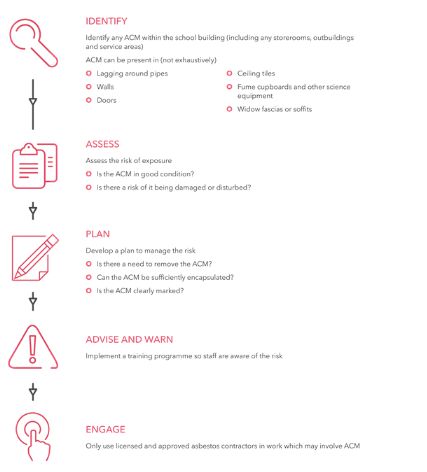The Guardian recently reported that around 700 schools in the UK may be failing to manage asbestos within their estates. The All Parliamentary Group on Occupational Health and Safety estimates that 75% of state schools in Britain contain asbestos. The National Union of Teachers (NUT) aims to have all asbestos removed from schools whatever its location and condition. However, Professor Peto, Cancer Research UK Chair of Epidemiology at the London School of Hygiene and Tropical Medicine and the Institute of Cancer Research, recently stated that to remove asbestos would release more fibres, and therefore present more of a risk, than leaving it in place and effectively managing it.
Asbestos remains a safe material, if it is not disturbed and the asbestos fibres are not released. However even common place activities such as slamming a door, removing a book from a shelf, or pinning a drawing to a wall could give rise to asbestos exposure.
A particular challenge for schools is the effective management of the asbestos risk as the location of asbestos containing material ("ACM") may not be known or clearly marked.
Exposure to asbestos, even at low levels, can cause mesothelioma, an invariably fatal cancer. The incidence of mesothelioma is rising and is currently responsible for approximately 2,500 deaths a year in the UK. Since 2001 more than 200 teachers have died as a result of asbestos related cancers.
There is evidence that exposure to asbestos at a younger age is more harmful than exposures in later life and therefore special consideration needs to be given to the potential exposure of children to asbestos.
How to Manage the Risk
The HSE has prepared an asbestos management checklist for schools which can be found here: http://www.hse.gov.uk/services/education/asbestos-checklist.pdf
How we can help

Claims:
The increased awareness of mesothelioma combined with a string of cases starting with Bussey v Anglian Heating have made the continued defence of claims for low level exposure cases, such as would likely be encountered by employees and pupils in schools, increasingly difficult to maintain.
Our expert Disease lawyers are able to quickly identify those cases which ought to be settled and those which ought to be fought. Swift resolution of the issue of liability ensures that costs are kept to a minimum and the expense of litigation is reduced as far as possible. We carefully consider whether the statistical evidence of low level, transient exposures would amount to an insignificant risk or would not materially contribute to the risk and whether it would afford a defence.
Risk Management:
We can; help identify suitable experts to assist in preparing asbestos surveys and planning any remedial action; assist in the preparation of risk assessments and training materials; and if required deliver training on the risks of asbestos
HSE Prosecutions and Enforcement:
Our regulatory team can provide proactive health and safety advice and training; review policies and procedures; provide advice and representation in the event of an investigation by HSE or other regulatory authority. Ensuring you are informed, prepared and properly advised every step of the way.
The content of this article is intended to provide a general guide to the subject matter. Specialist advice should be sought about your specific circumstances.


